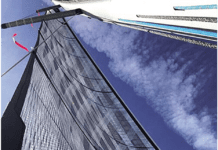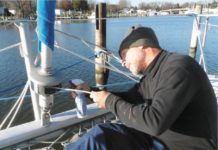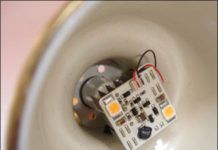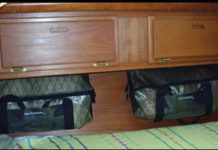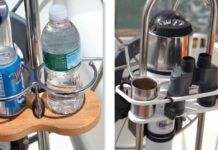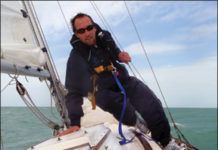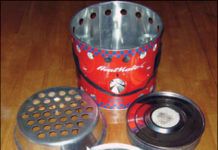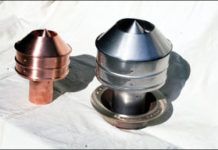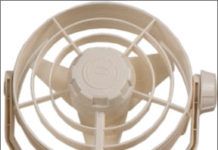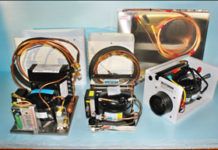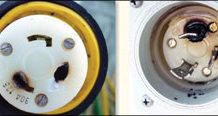A Permanent Mount for the Sensibulb LED Reading Light
I have always been a big fan of brass berth lights, but have never really liked the halogen bulbs commonly used in them. The little halogen bulbs run hot, use a lot of power, and are prone to vibrating loose. When Sailor's Solutions (www.sailorsolutions.com) introduced the Sensibulb, I quickly ordered a couple to test in our custom built boat Suzy. They worked so well that I converted all six of our berth lights. The original Sensibulbs were nice units, but the mounting system was iffy. I elected to bypass the mounting system by removing the ceramic bulb holder and directly gluing the bulb support post to the back of the Sensibulb.
The Canvas Air-Conditioner
Even the most dedicated sun worshipper craves shade after a bright, hot day on the water. For those of us whose goals include keeping our skin intact over time, a way to get out of the sun is imperative if we are to enjoy being in the cockpit at anchororinaslip. The problem is that few sailboats come equipped with usable shade, at least when the sails are down. The solution to the shade problem is a sun awning. A sun awning also solves another problem, particularly in tropical climates. By keeping the deck shaded, and by preventing the sun from streaming through deadlights and open hatches, an awning is a big help in keeping the temperature of the cabin interior at a habitable level.
Right Track Offers a Creative Storage Fix
Even the best laid-out boat interior has areas of wasted space begging to be utilized. Right Track Designs storage system puts that dead space to use. Right Tracks system, distributed by Sailing Angles Inc., comprises removable storage bags and tracks to hang them on. The zippered bags come in standard and custom styles and fabrics, ranging from laminated sail cloth or clear PVC plastic (so you can see the bags contents) to mesh fabrics for wet gear.
The Top 4 Drink Holders for Your Boat
Weve spilled our share of drinks on board, and while its a shame to see a fresh drink go to waste, some beverages can stain cushions and decks. Drink holders can help minimize onboard spills, but there are a million types marketed to boat owners-from basic lifeline-mounted wire baskets to expensive Starboard or teak binnacle boxes. To find out which is most effective, Practical Sailor field-tested a sampling from several manufacturers. Three of the 10 test products were of the old-style, gimbaled wire-basket variety that hang from a lifeline: the Sail-Buoy, the Sail-a-long, and one from Snap-It. From Edson and Snap-It, we evaluated rail- or pulpit-mountable holders made of stainless and Starboard (high-density polyethylene) and three binnacle-mounted products that can accommodate multiple drinks. The two products we tested designed to mount on vertical surfaces like a bulkhead were the Sea-Fit and the Bar-buoy.
Mailport: April 2010
Letters to Practical Sailor's April 2010 issue include: MOB drills, tethers, nav lights, cleats, no-buff shines and tankless water heaters.
HeatMate Takes the Chill Off
When temperatures decrease, the search for viable heating options by shivering sailors invariably increases. A recent cold winters night provided the perfect opportunity for one blue-nosed liveaboard Practical Sailor tester to check out the HeatMate 5200 heater-stove from Contoure International Inc. The HeatMate 5200 is a portable, non-pressurized alcohol heater that easily converts into a stove. Weighing in at about 5 pounds, the fairly compact, aluminum unit measures approximately 11.75 inches tall by 11.5 inches in diameter, and it comes assembled and ready to go.
Navigator Wood Stoves Provide Classic Heating and Cooking Onboard
Navigator Stoves, based on Orcas Island in Washington state, produces three classic wood-burning stoves for use onboard boats and in cabins, RVs, and other small structures. The Little Cod and Sardine stove models are produced using the patterns originally made at the Lunenberg Foundry in Nova Scotia. The Halibut stove model is based on an old favorite, the Shipmate stove. The cast-iron custom-made stoves and can be ordered in the original stove polish or one of six porcelain enamels. They can burn wood and charcoal. The Halibut stove model can also burn coal. For use in warmer months, Navigator has designed denatured-alcohol drop-in burners for cooking.
Cabin Fan Test Returns
In April 2008, Practical Sailor evaluated 11 cabin fans from seven manufacturers. Since that test, Caframo has gone back to the drawing board and redesigned its 748 Bora. The company also introduced a new weatherproof version of its Kona. Testers were pleased to see that the new fans clearly addressed complaints raised in our last test: The Bora radically changed its blade design to pump more air, and the Konas corrosion-prone metal grill was replaced with a plastic grill that will hold up better in salt air. Based on the new data, the Bora has climbed up into the recommended rankings. Stay tuned for this years Fan Death Match.
Conversion Kits that Turn Your Boat’s Ice Box Into a Galley Refrigerator
Practical Sailor tested three kits that convert onboard ice boxes into full-fledged refrigeration systems. The three reefer conversion kits in the review-the Waeco-Adler Barbour Cold Machine (CU 100) from Dometic Corp., the Frigoboat Capri 35F by Veco SPA, and the Sea Frost BD-represent a cross-section of whats available on todays refrigeration conversion kit market. Testers looked closely at energy efficiency and the 12-volt units abilities to cool a small ice box with the least amount of amp hours possible. Testers looked at quality, details, reliability, and cooling capacity.
Shore-Power Boat Fire Protection
With the increased demand to have all the electrically powered comforts of home onboard, it should come as no surprise to boaters that the majority of AC-related electrical fires involve overheated shore-power plugs and receptacles. Prime Technology, aims to change all that with the introduction of its Shore Power Inlet Protector (ShIP for short), a monitoring and alarm device that automatically disconnects AC shore power when excessive heat is detected at the power inlet connector. We reviewed the ShIP 110 designed for use with a 110-volt, 30-amp system. The company also offers a similar unit (the ShIP 220) for use with 220-volt, 50-amp service. Charred plugs and receptacles are the result of resistance build-up (due to loose or corroded connections), which generates heat and the potential for fire, a problem especially prevalent among vessels that continually run high energy loads such as water heaters and air-conditioning units. In addition to monitoring the temperature of your vessels shore-power inlet plug and its wiring, the ShIP system automatically disconnects AC shore power when an unsafe temperature is detected, providing visual and audible alarms. (The audible alarm shuts down after five minutes to avoid prolonged disturbance to surrounding boats.)













